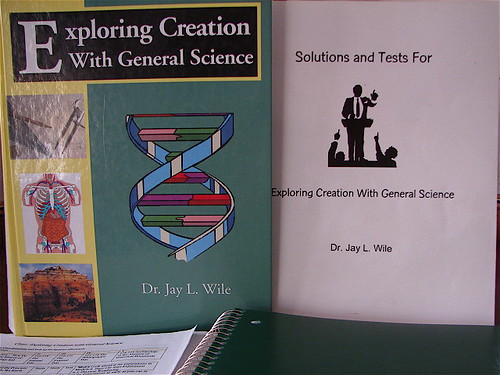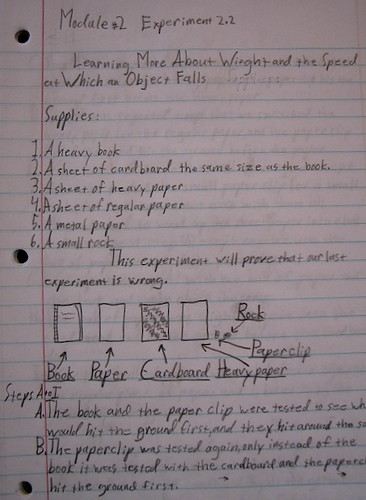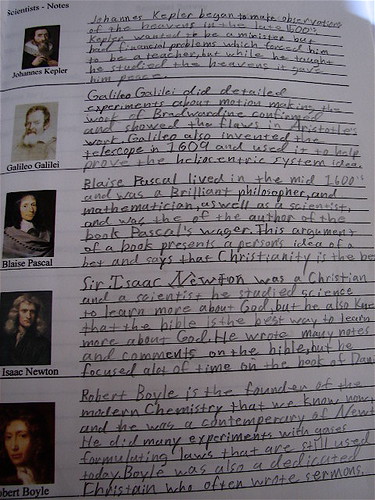Apologia’s Exploring Creation with General Science has been a perfect fit for our son, Nathanael, who’s in the eighth grade (age 13/14) this year. It is the first course of the Exploring Creation with… upper level Creation-based science curriculum series written by former University Professor, Dr. Jay Wile, especially for homeschool students. 
This course is designed to be a student’s first systematic introduction to the sciences. Although it can be used for eighth grade (especially if the student has recently left the public schools), it is typically used best in the seventh grade. The course covers such topics as the scientific method, designing experiments, simple machines, archaeology, geology, paleontology, biology, and human anatomy and physiology. Its scope, therefore, is quite wide. There are many hands-on experiments to do, and they all use household items.
I am glad that we waited to begin this course until eighth grade, for Nathan, and with him working on Physical Science next year, this will still place him in Biology in his 10th grade year, which is where many other curricula schedule it anyways (BJU, Abeka, etc.). I think that Apologia must recommend it for seventh grade, since they’re assuming your child will complete one of their upper level science courses also (Adv. Chemistry or Adv. Physics). This is certainly something to consider if your student is headed towards a science career. However, for our purposes, this course has been just the right speed for Nathan this year, who will still be completing four years of lab sciences in his highschool years. From our experience with Apologia’s General Science this year, the two attributes of this program that have stood out the most in my mind have been:
- Principles of Creation Science, Applied & Discussed Throughout. I have especially appreciated how this course has not only presented our son with an abundance of clearly explained fundamental science concepts and terminology, but also how the information is presented, conversationally framed within a Biblically sound creation-based worldview. This has been refreshing, particularly with all of the evolutionary/millenia mantras we’re so often inundated with when enjoying so many otherwise wonderful science/nature books, or watching our favorite nature shows and science documentaries on tv.
- Good Study Skills & Habits, Facilitated, Learned & Applied. Our son’s been learning more than just science! This easy-to-use course has offered a timely means by which Nathan has been learning some invaluable study habits! His independence with this course has really instilled a level of self-confidence and sense of accomplishment in him that we’re both enjoying. He likes knowing exactly what’s expected of him, and being able to “knock it out”, while I’m enjoying not having to tell him what to do every day! He has risen to the challenge of memorizing ALL of his Vocabulary words’ definitions for tests, which he also diligently records in his notebook as he’s reading the text, along with his answers to the On Your Own questions spread throughout each module. He’s learning how to reword essay questions within his thoughtful answers, and is actually even enjoying the whole process of seeing his efforts in studying for a test pay off with a good score! So overall, this course has offered our young student a perfectly balanced taste of traditional schooling methods that our Charlotte Mason, relaxed-eclectic homeschool hadn’t yet offered him much of up until now (besides his math).
How We’ve Used this Curriculum: My goal was to set Nathan up with enough organization and direction so as to enable him to be virtually independent in this course, and yet I wanted to be able to oversee his progress and know that he’s getting the most out of this wonderfully informative course. The system that we set up has worked beautifully and provides just the right amount of accountability and structure to keep him on track, while simultaneously allowing me to see where he needs correction or encouragement. The first thing I did was print out a schedule from DonnaYoung.org, where you’ll find lots of wonderful resources and helps for this and other books in the Apologia Science Curriculum line-up (even their Elementary series- which we’ve also used and recommend!). We’ve been using Schedule Two for the First Ed. of General Science (there’s also schedules for the Second Ed.), which spreads the first module out over three weeks (since there’s a LOT of information there in that first module!) and schedules most of the labs separately from reading days. 
- Module 1: A Brief History of Science
- Module 2: Scientific Inquiry
- Module 3: How to Analyze and Interpret Experiments
- Module 4: Science, Applied Science and Technology
- Module 5: The History of Life Archaeology, Geology, and Paleontology
- Module 6: Foundations of Geology
- Module 7: The Fossil Record
- Module 8: Uniformitarianism and Catastrophism
- Module 9: What is Life? (DNA)
- Module 10: Classifying Life
- Module 11: The Human Body: Fearfully and Wonderfully Made
- Module 12: Energy and Life
- Module 13: The Human Digestive System
- Module 14: The Human Respiratory and Circulatory Systems
- Module 15: The Human Lymphatic, Endocrine, and Urinary Systems
- Module 16: The Human Nervous System

- Dr. Wile has been answering student questions on each of these courses for seven years or more. Those questions have allowed him to realize what sections of the books could be written more clearly. Thus, these editions of our courses are even more understandable than the first editions!
- The student text has graphic icons that tell the student when there is a related multimedia presentation on the optional companion CD.
- There are course websites that have links to materials which provide extra help as well as interesting news related to each field.
- There are cumulative tests in the solutions and tests manual if the parent/teacher wants to give the student quarterly, semester, or final exams.
- The tests in the solutions and tests manual contain a point system that aids the parent/teacher in grading the tests.
- Finally, even though the module tests are found in the solutions and tests manual (so that the parent/teacher always has a copy of them), a second set of tests is also provided in a perforated booklet. This will allow the student to be given the tests without referring to the solutions and tests manual.
PLEASE NOTE: Because of the differences between the first and second editions, students in a group setting cannot use both. They must all have the same edition. Because of this, the first edition of the course will still be available for those in schools or support groups that use the first edition.
Differences in the Editions of the General Science text specifically, as described by cbd.com, are as follows:
This second edition includes updates on relevant topics as well as stylistic changes. The primary function of the appendix (discovered in 2006) has now been included, as have higher-quality drawings and more colorful illustrations. Online resources for advanced students and a review appendix have also been included in this 2nd edition. This kit contains both the student textbook and answer key.
Thus, the differences weren’t enough to matter much (to me), when I had such a good deal available on an immaculate copy of the First Edition, since the overall text and presentation is pretty much the same. Therefore, I think this review can serve as applicable to both editions. If you get the Second Edition, it will just be even nicer! We’re looking forward to trying out the multi-media CD that goes along with the Second Editions, like this one for General Science. 
The first module has been my favorite so far, because I found it interesting reading about all of the different scientists, since I love history. But one thing puzzled me; I didn’t understand why Benjamin Franklin wasn’t included in the list of well-known scientists who set the stepping-stones for modern-day science, and yet Alexander the Great was on the list. Overall, I find the course enjoyable.
However, I should mention here that he’s just now working on Module 9, and looking ahead at experiments and material covered as he studies “life”, I’m thinking that he’s going to be enjoying the second half of this book even more than the first! I’m excited anyways, and just so glad to have found such a dynamic science program! and the “Con” (the only one he could think of!):
I’ve liked most of the experiments so far, but some of them can be a little dry.
Again, after gathering the supplies for the experiments in this module we’ve just begun, and looking forward, I’m thinking that Dr. Wile saved the best for last in this book, and Nathan won’t be disappointed (I know that I’m not)!
Christian Book Distributors has the best price that I could find for buying the Apologia curriculum new.
General Science Lab Supplies Kit from Nature’s Workshop Plus! at cbd.com
Apologia Science: Exploring Creation with Biology (Charlotte Mason Style), A Squidoo Lense by HarmonyArtMom which I will certainly be referring to when we get to Apologia’s Biology in a couple of years. You can read more about how Barbara makes Apologia Science texts work for her family over at her blog, Harmony Art Mom.
Written by Beth Brewer, a Charlotte Mason inspired, Spirit-led, relaxed-eclectic homeschooling Mama of 3. She’s also an author at The Homeschool Post and blogs her photos, musings, hopes, fears, faith and falterings as she lives, loves and learns with her family at the brew*crew adventure.

Excellent info, Beth. I also own this curriculum and it looks great, although I haven’t used it yet.
We use the four-year science cycle (classical model) which puts us back at biology next year for 8th grade. I’m in a pickle about what to do – this (which doesn’t fit into any one science category), Apologia biology or stick to the game plan that’s worked so far which is unit studies.
I’ll be pondering over the next few weeks. Thank you for such a detailed post!
.-= Cindy´s last blog ..The Charlotte Mason Carnival Goes on a Woodland Walk =-.
Thanks for this review. I am considering using this next year for both my daughter & son(Gr 7 & 8) to do together.
.-= Sandpiper´s last blog .. =-.
Beth,
Thanks so much for sharing this! I am in the process of figuring out what to use next year for my 7th grader. {AH!} Someone else recommended this science to me, but your review really helps. I especially appreciate all the links to helpful articles.
.-= Renae´s last blog ..A Child’s Geography =-.
Wonderful review! Thanks so much for including all the helpful links. My oldest will be using this next year and I feel like I’ve already got a head start in planning now!
You’re welcome ladies, I’m so glad that you’ve found this info. helpful!
.-= Beth´s last blog ..Apologia Science: Exploring Creation with General Science =-.
its great site about Apologia Science curriculum.and thank for sharing.
.-= elementary science curriculum´s last blog ..Philadelphia School Districts: Offering a No Child is Left Behind Program =-.
Finders-keepers.net currently has Apologia books for $59.50, which is $0.01 different than CBD’s price. On Finders-keepers.net, orders over $50.00 have no S&H, so no need to have a shipping code, etc.
We are doing General this year. My oldest already did Physical and Biology. Apologia is why *I* fell in love with science! =)
Oh, and 1st editions of General and Physical are currently $11.99 for the SET, at Christianbook.com. It’s on their Bargains>phone specials page.
Wow!
Beth, I am wondering where you got the page in the photo above…the one that has the pictures of the scientists and lines to fill in information about them?
I got mine at DonnaYoung.org.
http://donnayoung.org/apologia/general-worksheets.htm